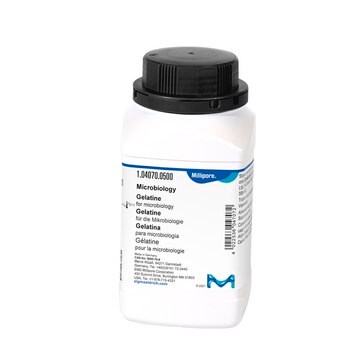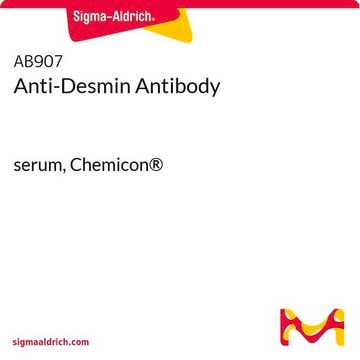About This Item
Produtos recomendados
fonte biológica
bovine skin
tipo
Type B
forma
powder
técnica(s)
ELISA: suitable
cell culture | mammalian: suitable
immunocytochemistry: suitable
western blot: suitable
Procurando produtos similares? Visita Guia de comparação de produtos
Aplicação
Gelatin has various industrial applications such as stabilizer, thickener, and texturizer in foods. It is also used in the manufacture of rubber substitutes, adhesives, cements, lithographic and printing inks, plastic compounds, artificial silk, photographic plates and films, matches, and light filters for mercury lamps. In the pharmaceutical industry, gelatin is used as a suspending agent, encapsulating agent and tablet binder. In veterinary applications it is used as a plasma expander and hemostatic sponge.
This product is recommended for use as a cell culture substratum at 1-5 μg/cm2 or 0.5-50 μg/mL. The optimal concentration does depend on cell type as well as the application and research objectives.
Gelatin was used for coating cell culture to improve attachment of cells, in addition to PCR to help stabilize Taq DNA. It was used as a blocking reagent in Western blotting, ELISA, and immunohistochemistry. Gelatin can also be used as a component of media for species differentiation in bacteriology. Gelatin is a biocompatible polymer and has been used as delivery vehicle for the release of bioactive compounds and in the generation of scaffolds for engineering applications.
It was used to test keratinocyte growth factor stimulation of gelatinase (matrix metalloproteinase-9) and plasminogen activator in histiotypic epithelial cell culture. It was also used to study the changes in the nucleolar organizer regions in the tuberomammillar region after dehydration.
Gelatin was used for coating cell culture to improve attachment of cells, in addition to PCR to help stabilize Taq DNA. It was used as a blocking reagent in Western blotting, ELISA, and immunohistochemistry. Gelatin can also be used as a component of media for species differentiation in bacteriology. Gelatin is a biocompatible polymer and has been used as delivery vehicle for the release of bioactive compounds and in the generation of scaffolds for engineering applications.
It was used to test keratinocyte growth factor stimulation of gelatinase (matrix metalloproteinase-9) and plasminogen activator in histiotypic epithelial cell culture. It was also used to study the changes in the nucleolar organizer regions in the tuberomammillar region after dehydration.
Componentes
Gelatin is a heterogeneous mixture of water-soluble proteins of high average molecular masses, present in collagen. Proteins are extracted by boiling the relevant skin, tendons, ligaments, bones, etc. in water. Type A gelatin is derived from acid-cured tissue. Type B is derived from lime-cured tissue.
Atenção
Dry gelatin, when stored in airtight containers at room temperature, will remain unchanged for many years. When heated at 100°C in the presence of air, it swells becomes soft and disintegrates to a carbonaceous mass with evolution of pyridine bases and ammonia.
Nota de preparo
This product is derived from bovine skin. Gelatin is soluble in hot than in cold water. It is practically insoluble in most organic solvents such as alcohol, chloroform, carbon disulfide, carbon tetrachloride, ether, benzene, acetone, and oils. The Bloom number, determined by the Bloom gelometer, is an indication of the strength of a gel formed from a solution of the known concentration. The Bloom number is proportional to the average molecular mass. Bloom numbers of porcine skin Gelatin vary from 90 to 300 g. This product has a gel strength of 50−120.
Código de classe de armazenamento
11 - Combustible Solids
Classe de risco de água (WGK)
nwg
Ponto de fulgor (°F)
Not applicable
Ponto de fulgor (°C)
Not applicable
Equipamento de proteção individual
Eyeshields, Gloves, type N95 (US)
Certificados de análise (COA)
Busque Certificados de análise (COA) digitando o Número do Lote do produto. Os números de lote e remessa podem ser encontrados no rótulo de um produto após a palavra “Lot” ou “Batch”.
Já possui este produto?
Encontre a documentação dos produtos que você adquiriu recentemente na biblioteca de documentos.
Os clientes também visualizaram
E E Putnins et al.
The Journal of investigative dermatology, 104(6), 989-994 (1995-06-01)
The purpose of this investigation was to examine the role that keratinocyte growth factor (KGF) plays in the control of matrix-degrading protease activity in epithelial cells. The culture conditions had a significant effect on cellular responses to the growth factor.
PCR Primer
C. Dieffenbach and G. S. Dveksler
PCR Primer: A Laboratory Manual (1955)
Pavel Khramtsov et al.
International journal of pharmaceutics, 599, 120422-120422 (2021-03-02)
The desolvation technique is one of the most popular methods for preparing protein nanoparticles for medicine, biotechnology, and food applications. We fabricated 11 batches of BSA nanoparticles and 2 batches of gelatin nanoparticles by desolvation method. BSA nanoparticles from 2
Chang-Sheng Wang et al.
Carbohydrate polymers, 175, 484-492 (2017-09-18)
Gelatin B and xanthan gum aqueous mixtures (GB/XG, (0.2-2%)/0.2% w/v) exhibit enhanced gelling properties compared to their pure component solutions at similar compositions. The mixed gels comprise co-localized networks of GB and XG-rich domains. Our results show that these domains
Pavel Khramtsov et al.
Pharmaceutics, 13(10) (2021-10-24)
Gelatin nanoparticles found numerous applications in drug delivery, bioimaging, immunotherapy, and vaccine development as well as in biotechnology and food science. Synthesis of gelatin nanoparticles is usually made by a two-step desolvation method, which, despite providing stable and homogeneous nanoparticles
Nossa equipe de cientistas tem experiência em todas as áreas de pesquisa, incluindo Life Sciences, ciência de materiais, síntese química, cromatografia, química analítica e muitas outras.
Entre em contato com a assistência técnica













